
Plague Quarantine Page Menu: 1 2 3 4 5 6 7 8 9 10 11 12 13 14 15 Next>>
Golden Age of Piracy Maritime Quarantine For Plague, Page 8
Quarantine at the Mediterranean Lazarettos: Goods
Goods thought to carry infection were also subject to quarantine during the golden age of piracy. In the early periods of plague quarantine, suspect goods were burned to avoid risk of infection. Medical historian Gunter Risse

Artist: Henri Félix Emmanuel Philippoteaux - Burning Goods (19th c.)
says that in Venice during the fifteenth century, "all goods deemed infected had been summarily burned and destroyed"1. Fellow medical historian Charles Savona-Ventura says that even more drastic actions were taken in Malta up to the mid-sixteenth century. "Ships suspected of harbouring infection were directed to Marsamxett Harbour. Attempts to contain the infection included the burning of cargo, isolating the crew and submersing the ship."2
Such drastic responses were moderated over time, probably due in large part to the desire to maintain trade between different cities and countries. Risse explains that the forty day plague was employed because it was believed "that noxious plague-producing particles imbedded in textiles not only could be removed through exposure to sunlight and fresh air, but also cold and hot water washings. Some materials were treated with salt water."3 By the golden age of piracy, such practices were well-established and the burning of cargos had been replaced by quarantine for the most part.
Goods which were required to be aired and/or washed were listed, sometimes in the rules of the lazaretto.
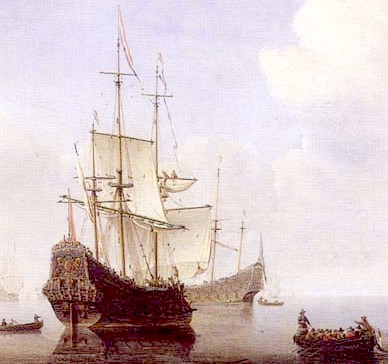
Artist: Willem van de Velde the Younger - Ships Riding Quietly (17th c.)
The 1695 rules for the Messina lazaretto state that only those things listed were subject to infection and so were to be quarantined.4 John Howard explains that the goods which were not susceptible to infection at Venice "may be unloaded on the ship's arrival, after obtaining a mandate [from the Bureau of Health], and in presence of a messenger, who must be always within sight, as well as the ship's guardian on board."5
As with people and ships, bills of health affected how goods were processed at lazarettos, although Howard notes that a clean bill of health alone was not enough for immediate unloading of goods having the potential for infection at Marseille. He says vessels arriving there were "subject only to twenty days quarantine: unless it be one of the two first ships [to come from a place], or there have been an account that the plague had broke out after it had sailed from the port where it was loaded"6. The twenty day quarantine of goods with a clean bill is also required by the 1716 Marseille lazaretto instructions.7 Howard also notes that when the plague was anywhere in the the eastern Mediterranean sea, "five days are added to the twenty days of the quarantine: this the French call pied de mouche."8 This is not mentioned in the 1716 instructions, however.
The 1695 Messina rules had a similar, although less rigorous, quarantine period of ten days for goods coming from suspect places with a clean bill of health. This can be discerned from the rule explaining that suspect goods brought into Messina with a clean bill of health must still have "made quarantine in another Mediterranean port, which should be reported as being ten days, do not need to be subjected to a quarantine and do not have to pay the usual fees"9.
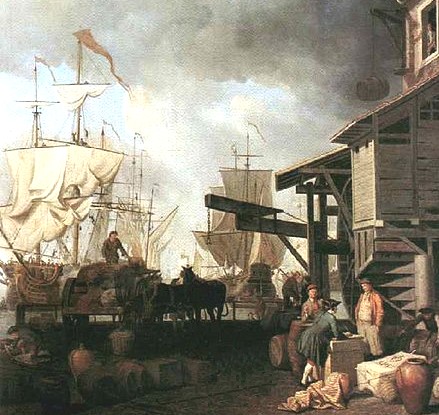
Artist: Samuel Scott - A Thames Wharf (c. 1757)
If such goods had not performed a ten day quarantine elsewhere, this rule says they would be required to do so at Messina. The Serenissima Republic instructions for Corsica, Caprara Island and Genoa dated 1661 specifically noted that any merchandise that was being shipped from within the Serenissima's Dominions where the plague was not present was to be given pratique 'without delay'.10
The quarantine period for goods arriving without a clean bill of health varied between periods and places. In Vicenza, Italy during the late sixteenth century, foul merchandise was quarantined for sixty days, while cloth and rigging from the ship was quarantined for fifty.11 As already established, the typical quarantine for goods in Italian lazarettos in the late seventeenth and early eighteenth century was forty days. Goods coming to Marseille in 1716 on ships with suspect or foul bills of lading were to be quarantined for forty days.12 Historian Daniel Panzac agrees that suspect goods coming into Marseille were to serve forty days, however he also says those with a foul bill of health had to be in quarantine for fifty.13 (Panzac writes particularly about the latter half of the eighteenth century in the main part of his text and unfortunately does not explain when this modified rule was enacted.) At the Manoel Island lazaretto on Malta in the eighteenth century, the quarantine for goods was thirty-five days.14
Ships were permitted to have someone serve quarantine in the lazaretto where the goods were being aired to make sure that no damage was done to them and, if necessary, to speak on behalf of the owners of the goods. The Marseille instructions refer to this person as the scribe or writer, possibly referring to the ship's supercargo. They explain that this person is obliged to perform their quarantine either in the lazaretto or with the goods and will "visit [the covered warehouses or other location of the goods] twice a day to be sure the Merchandise is in good order"15. The instructions also note that goods were not to be removed from the covered warehouses even to bring them to the scribe's room in the lazaretto.
1 Guenter B. Risse, Seventeenth-Century Pest Houses or Lazarettos, Jan. 1999, p. 29; 2 Charles Savona-Ventura, Knight Hospitaller Medicine in Malta [1530-1789], 2015, p. 46; 3 Risse, p. 29; 4 Instruzzioni e gouerno del lazzaretto di Messina per la scala franca, 1695, p. 26 - translated by the author; 5 John Howard, An Account of the Principal Lazarettos In Europe, 1791, p. 20; 6 Howard, p. 5; 7 Daniel Panzac, "Appendix 1: INSTRUCTION POUR LES INTENDANTS DE LA SANTE SUR LES USAGES & COUTUMES DU BUREAU", Quarantines et Lazarets, 1986, p. 135 - translated by the author; 8 Howard, p. 5; 9 Instruzzioni e gouerno del lazzaretto di Messina... p. 26; 10 Simona Olivieri, "Istruzione ed ordini per la Sanità da osservarsi in tutti quei luoghi che hanno giurisdizione al mare, nell'una e l'altra Riviera della Serenissima Repubblica, compreso il Regno di Corsica, ed isola di Caprara", La Berio, Jan-Jul, 1999, p. 27; 11 Panzac, "Appendix 1...", p. 135; 12 John Macauley Eager, "The early history of quarantine", Yellow Fever Institute Bulletin No. 12, March, 1903, p. 23; 13 Panzac, "Appendix 1...", p. 135; 14 Paul Cassar, A Tour of the Lazzaretto Buildings (Malta), 2004, p. 373;15 Panzac, "Appendix 1...", p. 136
Goods' Quarantine - Bringing Goods to the Lazaretto
Lazarettos needed to have a lot of space available to air goods. Speaking about the Malta lazaretto on Manoel Island, John Howard described two large courts inside which were 101 feet by 63.1 Howard explains that these areas were covered so that they would be protected from the elements. Modern historian Paul Cassar explains that the Manoel Island warehouses had an "arched ceiling
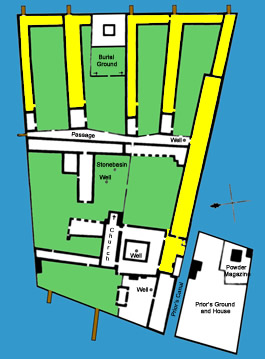
Goods Storage Sheds at Lazaretto Vecchio, Venice,
From Plan found in Howard
(1789)
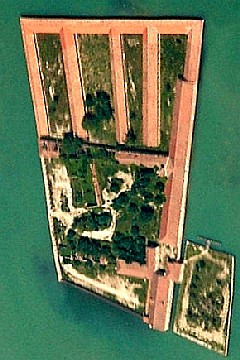
Photo: Wiki User Chris74
Lazaretto Vecchio, Venice
which were originally meant for the 'ventilation and purification' of merchandise before it was allowed into the island or trans-shipped to other ports."2 The 1716 Marseille quarantine rules specify that goods were to be placed in 'halles'3, which is French for "covered market or similar building"4.
Howard includes a plan of the old lazaretto at Venice which indicates where goods brought in for quarantine were stored and aired. The areas shown yellow in the drawing at left were warehouses where the goods were to be placed. (The green areas were open courtyards.) The image at right shows the lazaretto as it is today, providing an idea of the size of the warehouses.
Howard notes that goods were not allowed to remain on the ships arriving at Venice - those things not requiring quarantine were brought into the city while those to be aired were taken to the lazaretto. In Messina, the 1695 rules state that, under the direction of the guardian assigned to their ship, "the sailors of the vessel, or other vessels, will bring those goods or merchandise to the place directed by the Custodian or Under-Custodians of the lazaretto and said sailors will immediately return directly to their boats with their Guardian to avoid any disorder or inconvenience."5
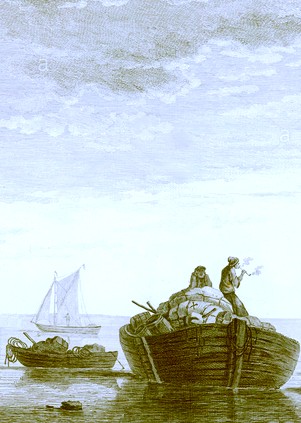
Artist: Pierre Charles Canot
Lighter (Barge), Vue des Environs de Flessingue, (18th c.)
Although the Messina instructions say nothing about how the goods were transported, Howard mentions that at the Marseille lazaretto, "goods are conveyed to the lazaretto in large boats kept for that purpose."6 Howard points out that the number of porters and guardians sent to oversee and assist in unlading a vessel "is proportion[ed] to the cargo; and four [porters and guardians] are allowed to a common ship."7
Howard also explains how goods were transported to the lazaretto at Venice, providing a more insight into the process.
Great caution is used in transporting merchandise to the lazaretto; the lighters [flat bottomed barges used to transport goods] must have no sails, or the prior detains them along with the goods; the ropes are well tarred [to prevent being infected]; the sailors belonging to the ship load them, and take them in tow with their own boats to the lazaretto, always accompanied by a messenger in going and coming. The prior receives them, as before observed, delivers them to the care of the porters and guardians, and they are accountable. One of the ship mates or seamen remains in the lazaretto for further guard to the goods, and to be answerable for the bills of lading, performing his quarantine there. When the whole cargo is unloaded, and properly disposed and ranged in the lazaretto, the quarantine of both ship and goods commences, and not before.8
Cassar mentions that once the goods had completed quarantine, "[t]hey were then repacked and re-embarked on lighters at one of the wharfs of the lazzaretto and sent to their destination."9 The Marseille quarantine rules said when the porters were removing goods from the lazaretto, they were not to roll soft goods up or throw them out of the
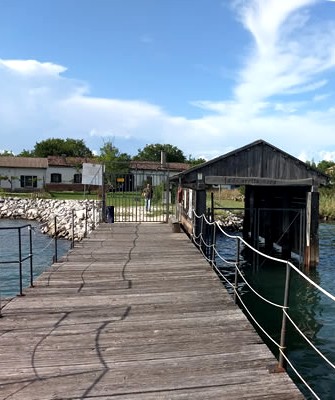
Photo: The Author
The Dock at Lazaretto Nuovo in Venice in 2018
windows of the structure. If they did so, they would be incarcerated for 8 days and be held responsible for any damage they caused to the cargo.10 Goods were not to be released from quarantine at Marseilles "until after the Bureau [of Health] has cleared them and received a Ticket from the Aldermen indicating that the Trade Fees have been paid."11
It was necessary to make sure that the goods from each vessel were aired for the appropriate number of days as well as to prevent anything from one cargo infecting another. This explains why each of the five goods storage sheds at Lazaretto Vecchio in Venice had its own dock (see the diagram at the top of this section) - that way the incoming and outgoing goods could not come in contact with another ship's quarantined goods when transported to and from the lazaretto. The Marseille instructions order that goods were only to be transported directly to and from the gates that led directly to the sea.12
Not surprisingly, neither the merchants waiting for goods nor the merchant sailors delivering them were fans of the this system. In the early 17th century, sailor George Sandy complained that even when ships arrived at Venice with a clean bill of health, "they are inforced to unlade at the Lazaretto. So under pretence of airing, their goods are opened; their quantity, quality and condition known; redounding much to their detriments. But for that we came from Venice, we were freed from this mischief, and presently suffered [allowed] to land."13 When trying to figure out how the implement quarantine in England in the early 18th century, much of the oppositions voiced to the procedure concerned the inhibition of trade as we shall see. This concern was likely a relic of the English sailor's experience of goods quarantine in the Mediterranean.
1 John Howard, An Account of the Principal Lazarettos In Europe, 1791, p. 8; 2 Paul Cassar, A Tour of the Lazzaretto Buildings (Malta), 2004, p. 373; 3 Daniel Panzac, "Appendix 1: INSTRUCTION POUR LES INTENDANTS DE LA SANTE SUR LES USAGES & COUTUMES DU BUREAU", Quarantines et Lazarets, 1986, p. 136 - translated by the author; 4 Halle, en.wiktionary.org, gathered 4/18/19; 5 Instruzzioni e gouerno del lazzaretto di Messina per la scala franca, 1695, p. 17; 6,7 Howard, p. 5; 8 Howard, p. 20; 9 Cassar, p. 373; 10 Daniel Panzac, "Appendix 1...", p. 138; 11 Daniel Panzac, "Appendix 1...", p. 130; 12 Daniel Panzac, "Appendix 1...", p. 135-6; 13 George Sandys, A relation of a iourney begun an dom 1610, 1652, p. 5
Goods' Quarantine - Processing In the Lazaretto
Whenever goods and people were to be quarantined in the lazaretto at Messina the custodian or his assistant had to be present to oversee the operation. It was the custodian's 'special responsibility' to make sure the goods were secured in the lazaretto and the airing process was properly performed.1 At Marseilles, the 1716 instructions identify the 'Captain' (like the Messina custodian) in charge of the lazaretto having that responsibility, assigning porters and guardians to each ship's quarantined goods as needed.2
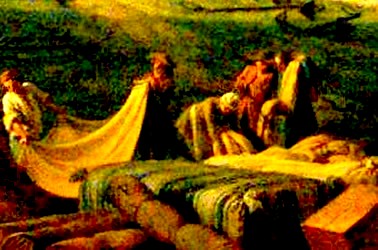
Artist: Claude-Joseph Vernet
Airing Goods, From Vue du port de Rochefort (18th c.)
While the custodian was responsible for the quarantine of goods from a ship, he also had to oversee the quarantine of passengers and goods from every other ship as well. To assist him, a guardian was assigned to each ship to oversee passenger and goods' quarantine in the lazaretto. He, in turn, oversaw the porters, who were in charge of making sure the goods in quarantine were properly aired or washed. The 1695 Messina lazaretto instructions explained that this guardian "must keep the strictest eye over the porters, that they neglect not their daily labour in airing and moving the goods under their care, and in case of negligence, want of punctuality or dishonesty, he informs the prior who complains to the magistrates, and the porters are punished."3
The Marseille instructions have a variety of rules about the behavior of the porters. For example, "Armed Guardians will be placed on Isle of Jarre to prevent the Porters who are purging Goods from communicating with anyone, and to provide them what they need."4 Porters were also ordered not "to sleep on the bails of the goods in purge"5 or they would be incarcerated for eight days. They were not to fish off the island under the same penalty. No one was to have a pipe lit when in or near the covered warehouses, clearly in an effort to avoid damage to cloth and other flammable goods in quarantine.
For each cargo, the lazaretto's porters moved the goods into the lazaretto,

Artist: William Daniel - Patrick Russel
(1794)
opening and setting them up for airing or washing. They also adjusting the cargo regularly to make sure that every part of it was exposed to air and sunlight to allow for an effective purge. John Howard explains that at the lazaretto in Malta, "different kinds of goods are separated, and placed in proper order under cover."6 Scottish surgeon Patrick Russell said that goods from each vessel had to be strictly segregated from goods from other vessels in every lazaretto.7 The Marseilles instructions likewise explain that the porters who move and turn the goods to assure complete airing must make sure that goods from different ships did not come in contact with each other.8
The cargo wasn't the only material required to undergo quarantine; the passenger's possessions were also subject, as mentioned previously. The 1695 Messina instructions direct the guardian in charge of each passenger group to check the passenger's possessions "in order to see if they have any merchandise subject to quarantine, because in this case such goods must be purged, as is the practice with all the other goods"9. Historian Paul Cassar mentions that at the Malta lazaretto, "The clothes and baggage of passengers were submitted to the ...process of airing."10
The Messina lazaretto instructions includes a list showing the cost of quarantining a variety of goods in its appendix. While the prices are not of much interest here, the list provides insight into which specific goods were believed to cause infection.
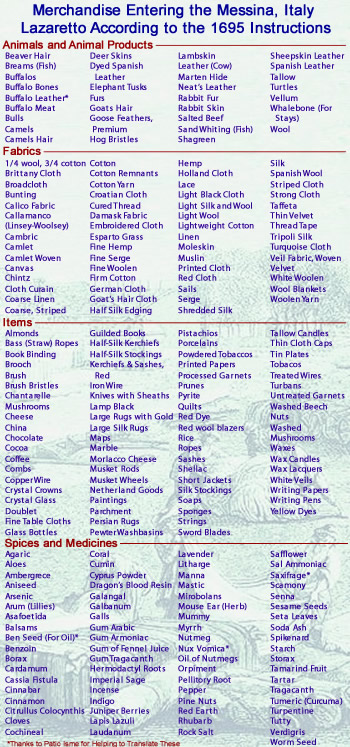
Image Artist: Claude-Joseph Vernet
Merchandise Subject to Quarantine in Messina Lazaretto in 1695
These products are found in the graphic at right. Since the actual rules only do not discuss goods in quarantine in such detail, the items included in the appendix have been divided here into four categories which relate to the way goods are discussed in text of the rules. These categories include Animals and Animal Products, Fabrics, Items, and Spices and Medicines.
The process for handling cotton and similar fabrics is mentioned by documents at a variety of lazaretto locations. At Marseille, Howard explains that incoming cotton on a ship with a foul bill of health "must remain on deck six days; and the next six days, the first bales must remain on the bridge in the lazaretto, before any others can be received by the porters"11. Ships with clean bills of health were processed much more quickly. Once ashore, "bales of Cotton are exposed to the open air; and every ten days, a seam of the bags is opened. Precious goods are placed in warehouses with open balustrades to allow the air to pass freely."12 From this it sounds as if some of the less exotic cotton bales may have been left outside, exposed to the elements.
The 1716 Marseille instructions state that cloth was to be treated differently depending on what type of bill of health the ship arrived with. Packages of cloth with a clean bill of health were to be placed under the covered warehouses where their ends were opened for airing for twenty days. Those with a suspect bill of health were to "be open on one side until the end of their purge, and when it is Cotton, the cords of the bails are to be released to make it easier for the fabric to catch the wind" for forty days.13 Suspect wool cargo was to be re-packed in new bags. When arriving with a foul bill of health, wools & linen was removed from its packaging and placed in stacks which were sorted by who was to receive them for forty days.
On ships were someone had contracted or died from the plague, cloth was to be removed from its packaging and placed in piles in tents on the Island of Jarre off Marseille [where ships and their crew performed quarantine] outside the lazaretto for thirty days. The tents were to be supplied by the ship on which the cargo had arrived. Once the thirty day quarantine was completed, the cloth was brought into the lazaretto where it had to serve a further forty day quarantine.14
The Messina instructions were a little less strict, stating that cotton and other fabrics such as linen "must be opened up and the merchandise must be raised [put on platforms] so that the porters can reach inside" to adjust the material inside so that it is all eventually opened to the air, allowing for complete purging.15 In his review of the lazaretto at Malta, Howard explained that cotton was to be removed from the bags containing it "and placed in rows of piles, upon boards laid on stone pillars about eighteen inches from the floor"16.
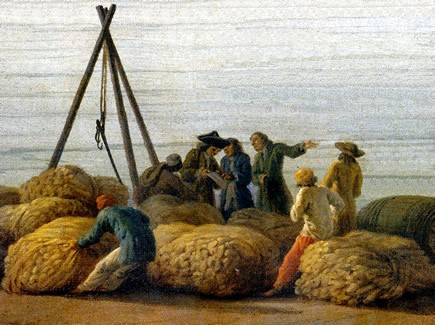
Artist: Claude-Joseph Vernier - Vue du port de Rochefort
(1761.)
The Messina rules state the cotton yarn bundles were to be opened, exposed to the air and turned from the bottom upwards. Bales of silk and goat's yarn were similarly treated, with an opening created in the center of the bale so that the porters could reach in and adjust the fabrics to allow for more complete exposure of the material inside. Containers of coarse cloths were to be opened and piled up in a manner which sounds similar to that described at Malta by Howard.17
Howard also explains the process of repacking cotton fabrics once they had served their quarantine: "they are flung over a man who gets into the bags, in order to tread down the cottons". This, he notes, would expose the man to great danger of infection if the airing had not been effective. He also mentions the problems this process created for the merchants shipping cotton and cotton products. While the seller transported the cotton to the port on camels, "the bales are often taken off on the roads, and laid in wet and dirty places where their outsides are injured. In consequence of being taken to pieces and repacked in the lazaretto in the manner now described, the injured parts get [mixed] among the inner parts, and the Cotton acquires the appearance of being wholly damaged; and, therefore, is rendered less marketable."18
Leather was usually not brought inside the lazaretto to be quarantined because of the smell. The Messina instructions explain: "The stink of said salty, wet leather which is produced by leather being ventilated does not have to be inside the fence of the Lazzaretto, but can be left out uncovered in the air"19. They also state that cowhides were to be piled in 'bunches' outside the lazaretto where "the wet, salted leathers will be put in so many piles from 50 to 100. per pile, and halfway through their purge they
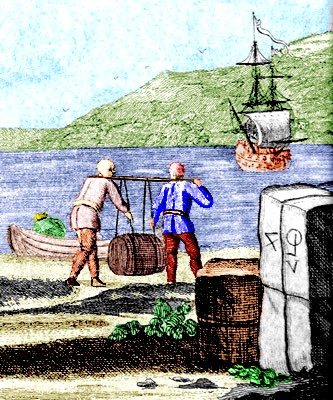
Artist: Joseph Nicholls - Loading Cargo (1736)
will be turned"20. The Marseille instructions likewise order leather to be placed on the Isle of Doume (rather than Jarre where ship quarantine took place). There, leather hides were "taken out of the bales and put into piles and those will be wet in the sea... in the presence of the Guards of the Bureau of Health."21 The guardians were also responsible for overseeing the porters in the turning of the leather.
At Messina, metal and wood were to be wet with salt water, which must have caused iron to rust. Salami was to have any packaging removed and then be placed in salt water. At Trafaria, wax and copper were similarly removed from their containers, which were subsequently burnt, with the wax a copper being submerged in salt water.
Other foods and spices were not so strictly treated there. Casks or chest of sugar coming into Messina had to be opened and shown to actually contain sugar, and then were allowed to be landed without further quarantine. Most other foods, spices and drugs were not themselves considered infectible, but they still had to be removed from their containers which were.22
Spices and drugs arriving in Marseille in 1716 were not to be taken off a ship until all other quarantinable goods had been removed. The instructions say that such things were only "to be put into other bags, and those in which it arrived are to remain in the lazaretto."23 The 1695 instructions for quarantine at Trafaria, Portugal are a bit more strict: "drugs, indigo, and the like, will be sent to the lazaretto because of the bales and barrels they are in, and, after being taken out, the containers will be burnt and the items placed in other cloth containers which are sent to the merchants in Lisbon."24 From these examples, it is apparent that the containers for food, spices and medicines were considered the problem, not the materials inside.
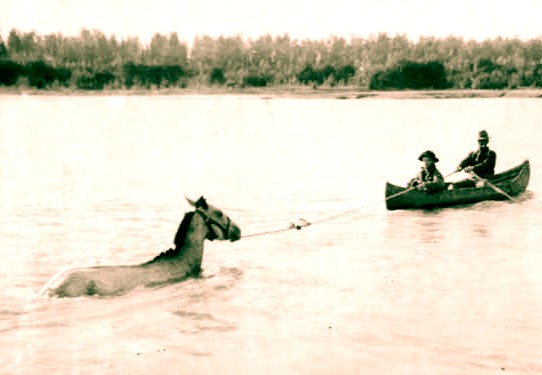
Artist: James Lennox McPherson - Horse Swimming, Guided by Canoe (1914)
Animals were also required to perform quarantine. The 1716 Marseille lazaretto instructions explain, "Horses and other Animals, including Poultry which comes from Suspicious Places, may be given to the Owners eight days after the arrival of the Ship on which they arrived by immersing them beforehand in the sea, first removing the Halters & Ropes."25
In explaining the procedure used at Venice in the late 18th century, Howard says, "Animals with wool or long hair, are liable to the whole quarantine [as other goods were]; but those with short straight hair are purged by causing them to swim ashore. The feathered animals are purged by repeated sprinkling with vinegar till well wet."26 Several animals are listed among the goods which were required to undergo quarantine in the 1695 Messina instructions although the actual procedure is not explained. Apparently the presence of animals created a housing problem at that lazaretto. Beginning some time after 1722, cattle sheds and courtyards with stone troughs were added to the lazaretto at Manoel Island, Malta to handle the quarantining of livestock. Historian Paul Cassar explains, "On the first floor of the cattle sheds, rooms were built for the storage of fodder and lodging the cattle-men."27
The Serenissima Republic instructions of 1661 for Corsica, Caprara Island and Genoa don't discuss the specifics of animal quarantine, but they do have rules about what to do with animals that have contracted and died from the plague."When cows, oxen, sheep and goats and such beasts die of the plague, the Health Officials will bury these animals with their skins, in which incisions will be made with a bladed weapon so that the said skin cannot be used, in the presence of at least one of the Deputies, buried in a deep pit so that they cannot be discovered and no one can skin them"28. While this rule may have applied to imported animals, it was more likely targeting those on land.
1 Instruzzioni e gouerno del lazzaretto di Messina per la scala franca, 1695, p.25 - translated by the author; 2 Daniel Panzac, "Appendix 1: INSTRUCTION POUR LES INTENDANTS DE LA SANTE SUR LES USAGES & COUTUMES DU BUREAU", Quarantines et Lazarets, 1986, p. 130 - translated by the author; 3 Instruzzioni e gouerno del lazzaretto di Messina... p.17; 4 Daniel Panzac, "Appendix 1...", p. 135; 5 Daniel Panzac, "Appendix 1...", p. 138;6 John Howard, An Account of the Principal Lazarettos In Europe, 1791, p. 16; 7 See Patrick Russell, A Treatise on the Plague, Vol. 2, 1791, p. 395; 8 Daniel Panzac, "Appendix 1...", p. 130 & 138; 10 Howard, p. 16; 11 Paul Cassar, A Tour of the Lazzaretto Buildings (Malta), 2004, p. 373; 12 Howard, p. 5; 13,14 Daniel Panzac, "Appendix 1...", p. 135; `5 Howard, p. 5; 16 Instruzzioni e gouerno del lazzaretto di Messina... p.25; 17 Howard, p. 9; 18 Instruzzioni e gouerno del lazzaretto di Messina... p.25;17 Howard, p. 9; 18 Instruzzioni e gouerno del lazzaretto di Messina... p.25; 19 Instruzzioni e gouerno del lazzaretto di Messina... p.26; 20 Instruzzioni e gouerno del lazzaretto di Messina... p.25; 21 Daniel Panzac, "Appendix 1...", p. 135; 22 John Macauley Eager, "The early history of quarantine", Yellow Fever Institute Bulletin No. 12, March, 1903, p. 23; 23 Daniel Panzac, "Appendix 1...", p. 135; 24 Eduardo Freire de Oliveira & Câmara Municipal de Lisboa, Elementos para a historia do municipio de Lisboa, Tomo X, 1899, p. 431; 25 Panzac, p. 135; 26 Howard, p. 21; 27 Paul Cassar, A Tour of the Lazzaretto Buildings (Malta), 2004, p. 373; 28 Simona Olivieri, "Istruzione ed ordini per la Sanità da osservarsi in tutti quei luoghi che hanno giurisdizione al mare, nell'una e l'altra Riviera della Serenissima Repubblica, compreso il Regno di Corsica, ed isola di Caprara", La Berio, Jan-Jul, 1999, p. 28

